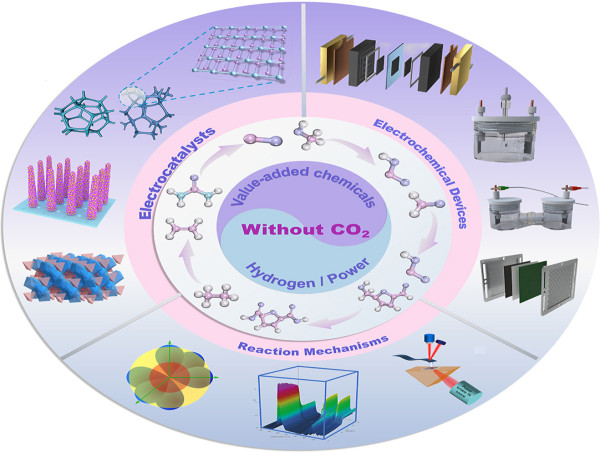GA, UNITED STATES, June 24, 2025 /EINPresswire.com/ -- Electrochemical conversion of small organic molecules offers a promising route to simultaneously generate hydrogen or electricity and value-added chemicals—without emitting carbon dioxide. This dual-function strategy enhances energy efficiency and sustainability, especially when using waste-derived organics, alcohols, or biomass as feedstocks. A recent review highlights how cutting-edge catalyst design, advanced electrochemical reactors, and mechanistic insights are advancing this field. Innovations in non-noble metal catalysts and tailored device architectures have shown potential in overcoming challenges related to selectivity, stability, and scalability. This comprehensive progress positions electrocatalytic conversion as a key technology in carbon-neutral energy systems and green chemical manufacturing.
As the world seeks cleaner and more efficient energy systems, the conversion of small organic molecules—such as alcohols, urea, and biomass—into energy and chemicals without carbon emissions is gaining attention. Traditional water electrolysis, although useful for hydrogen production, is energy-intensive due to the oxygen evolution reaction. Replacing this step with organic oxidation reactions not only lowers energy demands but also yields commercially valuable byproducts. This approach turns waste into wealth, addressing both environmental and energy concerns. However, challenges remain in catalyst durability, reaction selectivity, and system integration. Due to these issues, further research into materials, mechanisms, and reactor design is urgently needed to advance this promising technology.
A team of scientists from Shenzhen University and collaborating institutes has published a comprehensive review in eScience (January, 2025), summarizing breakthroughs in CO₂-free electrochemical conversion systems. The paper focuses on how electrocatalysts and reactors can be engineered to transform small organic molecules into hydrogen or electricity along with high-value chemical products. The study emphasizes the synergy of material science and reaction engineering in building efficient, eco-friendly systems for sustainable energy and chemical production.
The review identifies four major categories of organic feedstocks: wastewater contaminants (e.g., urea, formaldehyde), alcohols (methanol, ethanol), alkanes (ethane, methane), and biomass derivatives (5-HMF, furfural). Each class presents unique conversion opportunities and challenges. Replacing the oxygen evolution reaction in water splitting with selective oxidation of these organics enables substantial energy savings while yielding useful chemicals like formate, acetate, ethylene, or FDCA. To facilitate these reactions, researchers have developed a variety of electrocatalysts. Nickel-based systems—such as Ni(OH)₂, NiMoO₄, and NiCoP—demonstrate strong activity, especially when tuned with heterostructures, dopants, or coordination environments. For biomass conversion, cobalt- and copper-modified spinel oxides have proven effective in selectively oxidizing complex molecules. Advanced electrochemical devices, including flow cells, membrane reactors, and solid oxide fuel cells (SOFCs), enhance performance by improving mass transport and reaction control. Photovoltaic-electrocatalysis systems integrating solar energy further increase process sustainability. These combined innovations allow for high selectivity (> 99%), low energy consumption, and product yields that make industrial application increasingly feasible.
“Electrocatalytic conversion of small organic molecules is a game-changer in the field of green energy,” said Dr. Jing-Li Luo, co-author of the review. “Our work highlights how coupling value-added chemical production with electricity or hydrogen generation can redefine how we utilize organic waste and renewable resources. By optimizing catalyst design and reactor engineering, we’re getting closer to a scalable, carbon-neutral solution.”
This technology opens doors to transformative applications in sustainable energy, waste valorization, and green chemistry. In wastewater treatment, organic pollutants can be converted into energy and valuable chemicals simultaneously. In the chemical industry, the method allows the on-site production of platform chemicals from biomass, reducing reliance on fossil fuels. Integration with renewable energy sources enhances overall system sustainability. While challenges in scalability and cost remain, ongoing advancements in catalysts, reactor design, and process modeling point toward commercial viability. The approach aligns closely with global carbon neutrality goals and offers a compelling strategy for decarbonizing both energy production and chemical manufacturing.
References
DOI
10.1016/j.esci.2024.100267
Original Source URL
https://doi.org/10.1016/j.esci.2024.100267
Funding information
This work was supported by the National Natural Science Foundation of China (22272108, 22350710789, and 21975163), GuangDong Basic and Applied Basic Research Foundation (2024A1515011836), Shenzhen Science and Technology Program (ZDSYS20220527171401003, JCYJ20220531102408019, JCYJ20220818100004009 and KQTD20190929173914967) and the Start-up Funds for Young Teachers of Shenzhen University (000001032103).
Lucy Wang
BioDesign Research
email us here
Legal Disclaimer:
EIN Presswire provides this news content "as is" without warranty of any kind. We do not accept any responsibility or liability for the accuracy, content, images, videos, licenses, completeness, legality, or reliability of the information contained in this article. If you have any complaints or copyright issues related to this article, kindly contact the author above.
![]()



